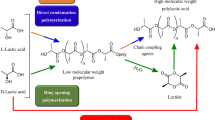Abstract
Semicrystalline poly(ethylene terephthalate) (cPET)/amorphous poly(ethylene terephthalate) with isophthalic acid (aPET) blends with 100/0, 75/25, 50/50, 25/75, and 0/100 by weight ratios were dissolved in a mixture of trifluoroacetic acid (TFA)/methylene chloride (MC) (50/50, v/v) and electrospun via the electrospinning technique. Solution properties such as solution viscosity, surface tension and electric conductivity were determined. The solution viscosity slightly decreased as aPET content increased, while there was no difference in surface tension with respect to aPET composition. The characteristics of the electrospun cPET/aPET blend nonwovens were investigated in terms of their morphology, pore size and gas permeability. All these measurements were carried out before and after heat treatment for various blend weight ratios. The average diameter of the fibers decreased with increasing aPET composition due to the decrease in viscosity. Also, the morphology of the electrospun cPET/aPET blend nonwovens was changed by heat treatment. The pore size and pore size distribution varied greatly from a few nanometers to a few microns. The gas permeability after heat treatment was lower than that before heat treatment because of the change of the morphology.
Similar content being viewed by others
References
J. Zeleny,Phys. Rev.,10, 1 (1917).
D. H. Reneker and Y. Chun,Nanotechnology,7, 216 (1996).
J. Doshi and D. H. Renekr,J. Electrostat.,35, 151 (1995).
J. M. Deitzel, J. Kleinmeyer, D. Harris, and N. C. B. Tan,Polymer,42, 261 (2001).
P. Gibson, H. Schreuder-Gibson, and D. Rivin,Colloids Surf. A.,187–188, 469 (2001).
Y. J. Ryu, H. Y. Kim, K. H. Lee, H. C. Park, and D. R. Lee,Eur. Polym. J.,39, 1883 (2003).
M. S. Khil, D. I. Cha, H. Y. Kim, I. S. Kim, and N. Bhattarai,J. Biomed. Mater. Res.,67B, 675 (2003).
K. Kim, M. Yu, X. Zong, J. Chiu, D. Fang, Y. S. Seo, B. S. Hsiao, B. Chu, and M. Hadjiargyrou,Biomaterials,24, 4977 (2003).
P. W. Gibson, H. L. Schreuder-Gibson, and D. Riven,AIChE J.,45, 190 (1999).
M. M. Bergshoef and G. J. Vancso,Adv. Mat.,11, 1362. (1999).
P. Viswanathamurthi, N. Bhattarai, H. Y. Kim, and D. R. Lee,Nanotechnology,15, 320 (2004).
X. F. Lu and J. N. Hay,Polymer,42, 9423 (2001).
J. Yu, B. Li, S. Lee, and M. Ree,J. Appl. Polym. Sci.,73, 1191 (1999).
A. Polyakova, D. M. Connor, D. M. Collard, D. A. Schiraldi, A. Hiltner, and E. Baer,J. Polym. Sci. Part B: Polym. Phys.,39, 1900 (2001).
J. Lei, M. Shi, and J. Zhang,Eur. Polym. J.,36, 1277 (2000).
W. Wong, K. Chan, K. W. Yeung, and K. S. Lau,J. Mater. Process. Technol.,132, 114 (2003).
A. Carlos and Y. L. León,Adv. Colloid Interface Sci.,76, 341 (1998).
K. H. Lee, H. Y. Kim, M. S. Khil, Y. M. Ra, and D. R. Lee,Polymer,44, 1287 (2003).
K. W. Kim, K. H. Lee, M. S. Khil, Y. S. Ho, and H. Y. Kim,Fibers and Polymers,5, 122 (2004).
Author information
Authors and Affiliations
Corresponding author
Rights and permissions
About this article
Cite this article
Kim, K.W., Lee, K.H., Lee, B.S. et al. Effects of blend ratio and heat treatment on the properties of the electrospun poly(ethylene terephthlate) nonwovens. Fibers Polym 6, 121–126 (2005). https://doi.org/10.1007/BF02875602
Received:
Revised:
Accepted:
Issue Date:
DOI: https://doi.org/10.1007/BF02875602




